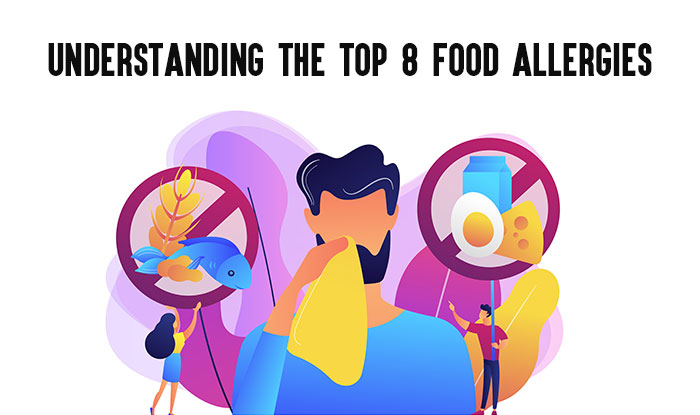The Top 8 or the Big 8 Common types of Allergies All you Need to Know

Food allergies have become an important topic in recent years for several reasons. Their incidence is increasing, affecting 30% of adults and 40% of children. People can be allergic to anything but 8 allergens are the most common.
What is allergy
When your body comes in contact with an irritant (known as an allergen), such as pollen, it starts an attack against it. Most of the time when this happens, we do not even get a clue about it. Sometimes, if there is an excess of allergen or your body is particularly sensitive to it, this immune response turns into overdrive. You get water in your eyes, your nose closes, or you turn into an itchy rash. Some allergies cause life-threatening reactions, such as anaphylaxis, leading to a sudden drop in blood pressure and contraction of the breathing airway.
Foods can also act as allergies. When someone is allergic to a food, they cannot eat it at all. Some allergies are so severe that people may not even have an irritant, because breathing or touching it can lead to anaphylaxis. An allergy is different from a food sensitivity or intolerance. Intolerance, such as an inability to digest milk (lactose intolerance), is generally not life-threatening, although it can cause discomfort such as bloating and diarrhea when swallowed.
These foods are the cause of 90% of recorded allergies and require labeling by the FDA to warn consumers about their presence or possible presence in foods.
1. Peanuts
Peanuts are actually legumes, which as a group are responsible for a large number of allergic reactions. People allergic to peanuts are unlikely to be allergic to other legumes, such as lentils. Children are more likely to be allergic to peanuts if they are already allergic to eggs.
2. ShellFish
Conch can also cause severe allergies. Crustaceans (shrimp, lobster, crabs) are the most common, although there may be some allergic reactions with mollusks (clams, mussels, oysters). Shrimp is considered to be the most allergic cause.
3. Fish
Pollock, salmon, cod, tuna, mackerel, and snapper are among the fish that usually trigger fish allergies. The fish muscle consists of an allergen protein parvalbumin. These allergies often develop during adulthood and are less likely to increase.
4. Milk
Milk allergy is one of the most common allergies in infants and young children. Milk allergy causes an immune response to the protein in milk. All milk, including cow, goat, and sheep milk, can cause problems. Most children overcome their milk allergies.
5. Eggs
Also common in children, both egg yolk and white can trigger a reaction, but in some cases egg yolk is less allergenic. Eggs are not only used in foods, but also in skincare products and cosmetics that contain eggs. Most children will overcome their egg allergies.
6. Soya
Even in the legume family, soy is an allergy that is likely to cause children to grow. Here in the United States, soy is found in most processed foods, either as soybean oil or soy protein isolate. People with soy allergies may be able to take soy lecithin without any problems.
7. Wheat
Wheat allergy is quite common and usually resolves in childhood. Wheat allergy is different from celiac disease. Celiac disease initiates a different immune response than other allergens. Genuine wheat allergy is uncommon in adults.
8. Tree nuts
One of the most powerful and common allergens, tree nut allergies affect 1.1% of the world’s population. Those affected by tree nut allergies should avoid Brazil nuts, macadamia nuts, cashews, almonds, pecans, walnuts, pistachios, chestnuts, hazelnuts, and pine nuts. Reactions associated with tree nuts are often severe, with walnuts and cashews most commonly reacting. At least 90% of children who are allergic to tree nuts will not pursue it.
Conclusion
Accuracy in food labeling is important for people with allergies, but it is not as easy to ensure when dining outside. Do not be afraid to ask your server or chef what is in the dish, including any allergens that the foods may come in contact with. It is in your interest to enjoy your meal safely!
